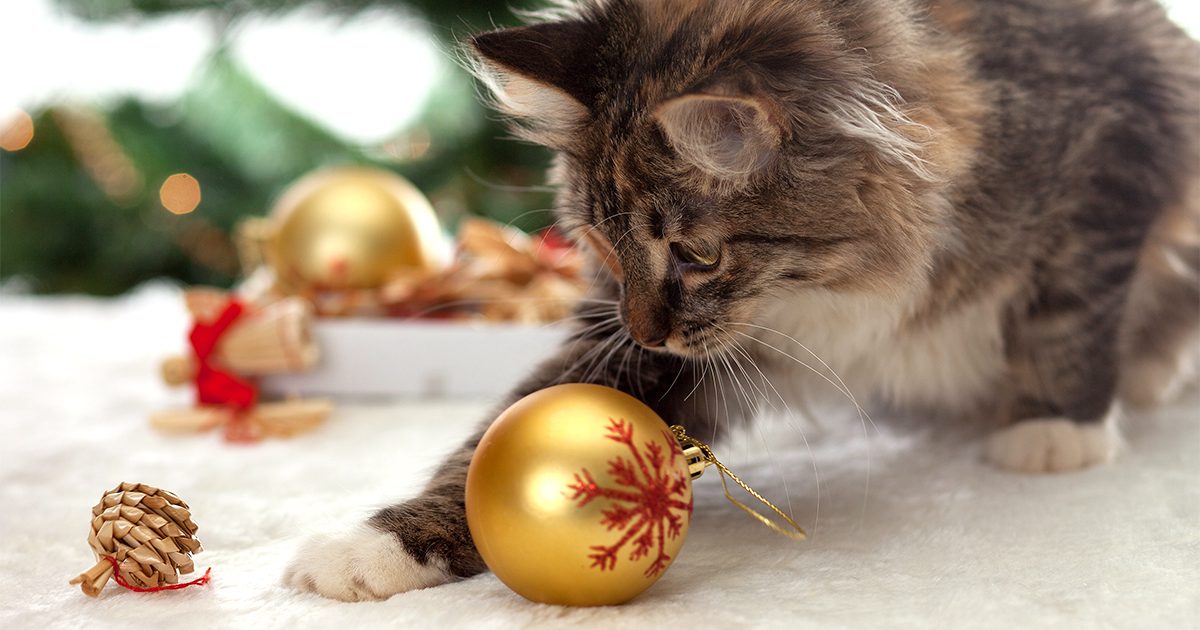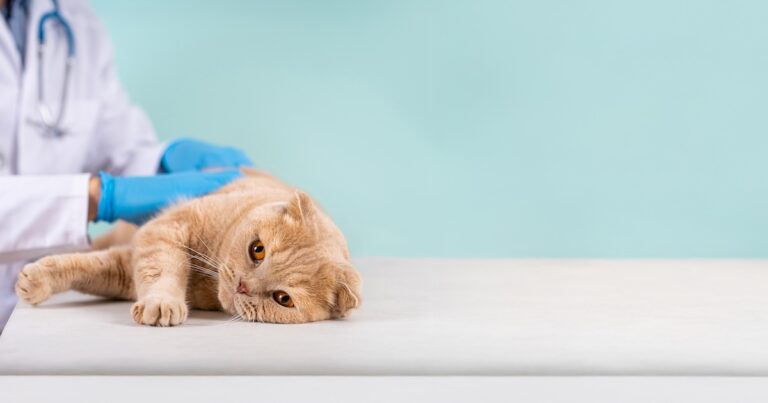December calendars are often filled with joyous celebrations with family and friends. But holiday festivities are also accompanied by hazards for your furry family members. Since nothing can take the ho-ho-ho out of your holiday like a trip to the emergency veterinary clinic, we’re sharing the 12 pet holiday dangers of Christmas. Be aware of these holiday hazards and you just may avoid a trip to the pet ER.
O Christmas tree, o Christmas tree, how lovely are thy…
Branches and boughs
Some cats see a Christmas tree as the ultimate cat toy, complete with scratching post, branches for climbing, a water bowl (if you have a live tree) and myriad dangling toys. Did we mention some trees come with twinkling lights and cords for chewing?
Yes, Christmas-tree-climbing cats can lead to chaos — not to mention toppled trees and broken ornaments. You can use fishing line or transparent nylon sewing thread to secure your tree to the ceiling and/or upper wall to keep it from tipping over when your crafty cat decides to climb and hide among the boughs. Consider putting your Christmas tree in a room with a door that can be closed to keep pets out — and potentially out of trouble.
If consumed by cats and dogs, pine tree needles and sap can cause nausea, vomiting or injury to the digestive tract. They can also irritate skin. Consider skipping the Christmas tree food or preservative. Commercial preservatives generally contain small amounts of fertilizer and dextrose (a type of sugar). Although today’s products are less toxic than older products, they can still cause mild vomiting and diarrhea if your pet drinks the tree water.
Ornaments
Holiday ornaments can present a variety of hazards, depending on how they’re made. Broken ornaments and those with sharp edges can cause lacerations. Small pieces that are swallowed by a pet can cause intestinal blockage or even toxicity, particularly if the ornament is made from salt dough.
Lights (and electrical cords)
Some cats and dogs love to chew on electrical cords, whether the cords run between tree lights or from light strand to outlet. To protect your pets, cover exposed cords in protective casing, tape them down or secure them under a rug. Also, turn off and unplug lights when you’re not home. Pets can be shocked or electrocuted by chewing on live electrical cords, which can lead to burns in or around the mouth, difficulty breathing, abnormal heart rhythm, seizures and worse.
Tinsel
Sparkly, dangling tinsel is very attractive to pets, especially cats, who enjoy batting it around and carrying it in their mouths. The problem is that if tinsel is swallowed, it can cause serious injury to the intestines, as it blocks the intestinal tract. If you suspect your cat — or other pet — has eaten tinsel, contact your veterinarian immediately.
You’re a mean one, Mr. Grinch…
(At least that’s what your pets may think when you keep these foods out of their paws and mouths.)
Bones and other holiday feast leftovers
During busy holiday celebrations, it’s easy to let clean-up slide for a bit, but that’s just what your dog, who may be an opportunistic scavenger, wants you to do. But this is one time you really need to be Mr. Grinch or Mr. Scrooge and clear leftover food from the table and counters so your pets can’t indulge themselves.
Many of our holiday feasts feature rich, often high-fat foods that can cause vomiting, diarrhea or potentially pancreatitis in our pets.
Cooked bones from meat, poultry or fish present a particularly dangerous threat because they’re brittle and more likely to splinter when chewed. If swallowed, bone splinters can become stuck in the throat, stomach or intestines. Or worse, the shards block the intestines or puncture the digestive tract, allowing contents of the intestines to leak into the abdomen. This is a painful, potentially life-threatening condition that requires surgery.
Be sure to dispose of carcasses, bones and anything used to wrap or tie meat (e.g., strings, bags, packaging) in a closed trash bag inside a covered, tightly secured trash container outdoors or behind a closed, locked door.
Chocolate
Chocolate and foods made with chocolate are essential to the holidays for many people but are dangerous to dogs and cats. Chocolate contains theobromine and caffeine, two compounds to which dogs and cats are very sensitive. Depending on the type of chocolate, the size of the pet and the amount that was eaten, chocolate can cause vomiting, diarrhea, agitation, high heart rate, abnormal heart rhythm, muscle tremors, seizures and worse. It’s best to keep any and all chocolate out of paws’ reach — and within yours!
Sugar-free baked goods and treats (xylitol)
Holiday cookies and candies are tempting treats for us and some dogs. In an attempt to trim calories or accommodate a diabetic family member, some holiday bakers may use a sugar substitute or artificial sweetener such as stevia or xylitol or ingredients that contain them. While most sugar substitutes aren’t toxic to pets, xylitol can cause life-threatening problems in dogs. Depending on the amount eaten, xylitol can cause low blood sugar (hypoglycemia) and even sudden liver failure.
Alcohol
Most people know not to give alcoholic drinks to their pets, but that’s not the only place to find alcohol during the holidays. Fruitcake that’s rum-soaked or made with bourbon- or brandy-soaked candied fruits can present issues for dogs and cats, not only from alcohol but also from raisins, sultanas and currants. Most pets that get into alcoholic beverages, however, tend to find unattended alcoholic drinks. Like people, dogs that lap up alcoholic beverages can become intoxicated. Alcohol is rapidly absorbed into the bloodstream and can quickly affect pets. Signs of alcohol intoxication in dogs include dangerous drops in blood sugar, blood pressure and body temperature, along with vomiting, decreased coordination, diarrhea, disorientation, difficulty breathing, tremors and worse.
Grapes and raisins
Grapes and raisins can be found at most holiday celebrations, as ingredients in fruit salad, trail mix and fruitcake. Yogurt- or chocolate-covered raisins as snacks or in snack mixes and grapes on appetizer platters can also mean bad news if your dog eats them. To learn more about the dangers of grapes and raisins, check out this article.
Deck the halls with…
Boughs of holly, mistletoe and other festive plants
You may want to think twice about decking your home’s halls and rooms with holly, mistletoe, amaryllis and Asiatic lilies. These beauties can be dangerous, even deadly, to cats and dogs. If your dog eats Christmas or English holly, the pretty plant with spiny leaves can cause severe gastrointestinal upset (e.g., nausea, vomiting and diarrhea) and injure your dog’s mouth, causing lip smacking, drooling and excessive head shaking. Dogs that eat small amounts of mistletoe may experience vomiting, drooling, diarrhea and abdominal pain. A large amount, however, could cause a slowed heart rate, difficulty breathing, low blood pressure and odd behavior.
While many people don’t associate showy, fragrant lilies with winter holidays, these big, beautiful blooms are actually quite common in holiday flower bouquets and arrangements. If you have a cat, you probably already know that members of the true lily family (Lilium spp. and Hemerocallis spp.) can be deadly. Even a small exposure can result in acute kidney injury and failure in our feline friends.
So, what about poinsettia and Christmas cactus? According to Pet Poison Helpline and the ASPCA Animal Poison Control Center, the potential “poisoning” of pets by poinsettias has been greatly exaggerated; and Christmas cactus isn’t toxic to either dogs or cats. Still, it’s a good idea to keep these plants away from pets. If chewed on or eaten, GI upset can occur.
Candles
According to the National Fire Protection Association, about 790 house fires each year are accidentally started by the homeowner’s pet or a wild animal. Most animal-related house fires are associated with cooking appliances, but unattended lit candles can also be a factor. So, if you’re lighting candles, menorahs and luminaries, carefully watch your pets. Dogs and cats are attracted to open flames, but they may burn themselves or start a fire if they knock lighted candles over. Consider a battery-operated flameless candle to avoid a trip to the pet ER or a call to the fire department.
Toyland, Toyland, wonderful world of joy land
Toys and battery-powered gadgets
With lots of new toys and gadgets around, chances are there are more batteries than usual around the home. Puppies and young dogs are often prone to chew (and eat) first and ask questions later, even if the item is not food. Larger toys can be chewed up and small parts can be swallowed, causing cuts in the mouth and intestinal blockages. If batteries are chewed and swallowed, they can cause chemical burns and obstructions.








